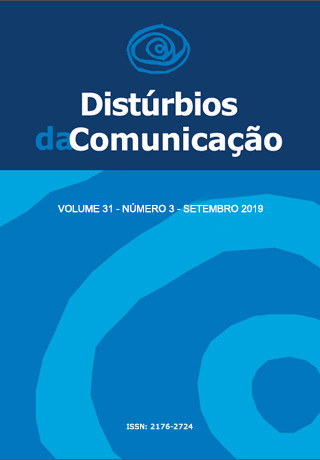Voice self-perception of public-school teachers
DOI:
https://doi.org/10.23925/2176-2724.2019v31i3p500-510Keywords:
Voice, Dysphonia, Quality of life, Occupational health, Adaptation, Psychological.Abstract
Introduction: The professional voice usage has some aspects that are inherent to each profession and the teachers present a high vocal risk. Purpose: To identify the perception that public-school teachers have of their own voices and the type and focus of coping strategies they use when they perceive vocal changes. Methods: Three vocal self-assessment inventories were answered by 100 teachers (EG) and 40 non-teachers (CG): 100 Word-Descriptors for Voice (WDV), Voice Activity and Participation Profile (VAPP), which allows the calculation of the Activity Limitation Score (ALS) and Participation Restriction Score (PRS), and Voice Disability Coping Questionnaire (VDCQ), that classifies the strategies used to cope with voice disorders into focus on problem and on emotion. Higher scores on VAPP and VDCQ indicate greater disability. Data were compared with a 95% level of confidence. Results: Teachers classified 53 descriptors as negative, with 1% to 40% of occurrence, against 40 descriptors of the non-teachers, with maximum 11% of occurrence. The total scores of the VAPP and VDCQ were, respectively per group, 41.95/13.37 and 37.90/10.23, and the ALS was 7.59/1.96 and PRS, 4.95/1.43. EG reported more (37.90) coping strategies than CG (10.23), and the emotion-focused (EG = 23.21 and CG = 6.53) coping strategies were more frequent than problem-focused (EG = 14.69 and CG = 3,70) ones. All data showed significant difference (p<0.05) between EG and CG. Conclusion: Teachers perceive the impact of changes in their voices, with greater impact on daily communication. They show greater occurrence of coping strategies to deal with these modifications in their voices and these are more emotion than problem-focused.
Downloads
Downloads
Published
Issue
Section
License
Copyright (c) 2019 Rayane Kelly Santana Santos, Raissa Dias Marques, Ana Carolina Nascimento Fernandes, Eduardo Magalhães da Silva

This work is licensed under a Creative Commons Attribution 4.0 International License.









